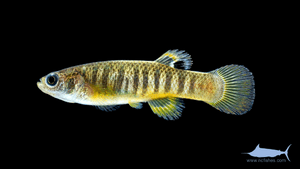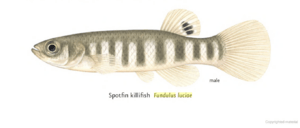Spotfin killifish facts for kids
Quick facts for kids Spotfin killifish |
|
|---|---|
 |
|
| Conservation status | |
| Scientific classification | |
| Synonyms | |
|
Hydrargyra luciae (Baird 1855) |
The spotfin killifish (Fundulus luciae) is a small, tough fish that lives its whole life in salty marsh areas that get flooded sometimes. It likes to hide in shallow puddles, small pools, and tiny streams that come and go with the tides.
This fish looks a lot like another fish called the mummichog (Fundulus heteroclitus). But you can tell them apart by counting the rays (the spiny parts) in their dorsal fin (the fin on their back). The spotfin killifish has 8 or 9 rays, while the mummichog has 11 or 12. Also, the spotfin killifish's dorsal fin starts further back on its body, a little behind its anal fin (the fin on its belly). The mummichog's dorsal fin starts more towards the front.
The spotfin killifish gets its name from a clear, eye-like spot (called an ocellus) on the back part of the dorsal fin of adult males. This fish is quite small, usually less than 50 millimeters (about 2 inches) long. You can find it along the east coast of the United States, from Massachusetts all the way down to Georgia.
Contents
About the Spotfin Killifish Family
The spotfin killifish belongs to a fish family called Fundulidae, also known as topminnows or killifishes. These fish live in fresh, salty, and slightly salty (brackish) waters in North America, Bermuda, and Yucatán. They are called "topminnows" because they often swim near the water's surface to get more oxygen when there isn't much oxygen in the water. Their mouths point upwards, and their heads are flat, which helps them do this.
The scientific name Fundulus actually means "bottom" in Latin. This is a bit funny because it probably refers to how many of these fish like to live in muddy areas and hide in the mud from predators. The name "killifish" comes from the Dutch word "kill," which means a stream or brook. It's a general name for a group of fish that lay eggs.
There are 38 different types of Fundulus fish alive today. They are found along the coasts and inland areas of the U.S., Bermuda, Cuba, and Yucatán. The spotfin killifish was first described in 1855 by a scientist named Spencer Fullerton Baird. He named it luciae to honor his daughter, Lucy Hunter Baird.
What the Spotfin Killifish Looks Like
The spotfin killifish is the smallest fish in its group, rarely growing longer than 50 millimeters (about 2 inches). Young fish become juveniles when they are about 10 millimeters long. Males are ready to have babies when they are about 24–27 millimeters long, and females when they are 28–30 millimeters long.
This fish has a long, slender body, not as thick as the mummichog. It has an upturned mouth, a flat head, and a rounded tail fin, which are common features for fish in this family. Adult males and females look different. Both sexes are darker on top and lighter on their bellies.
Young fish and adult females look similar. They are usually grayish-green to olive green. Females don't have the special spot on their dorsal fin, and usually don't have dark bars on their sides, though sometimes they might have faint ones. Adult males, however, have 10 to 14 dark vertical bars and the famous spot on their dorsal fin.
During the time they reproduce, male spotfin killifish get very colorful! Their bellies, and some of their fins and tail, turn a bright yellow-orange. Breeding males might also grow small, fleshy bumps on their heads, sides, and fins.
The spotfin killifish has 8 or 9 rays in its dorsal fin (usually 8), which is different from the mummichog, which has 11 or 12. Its anal fin has 10 rays. A key way to tell them apart is that the spotfin killifish's dorsal fin starts behind where its anal fin begins. This is different from other similar fish, including the mummichog.
Where Spotfin Killifish Live
The spotfin killifish lives in salt marshes that are often flooded by tides. These areas are full of tall grasses like cordgrass and needlerush. The fish makes its home in puddles, shallow pools, small tidal streams, and even in crab burrows. It stays in the marsh all the time, even when the tide is out.
Spotfin killifish like muddy ground. This is probably because mud holds water better than sand when the tide goes out. These fish can live in very salty water or water with almost no salt, but they prefer medium to high salt levels. In the wild, they have been found in water ranging from completely fresh to very salty.
It used to be thought that spotfin killifish were rare because their muddy, plant-filled homes are hard to study. But newer research shows that they can be found in large numbers in some places.
You can find spotfin killifish along the east coast of the United States, from Massachusetts down to Georgia.
Conservation Status
The spotfin killifish is listed as a species of "least concern" by the IUCN Red List. This means it is not currently considered to be in danger of disappearing.
What Spotfin Killifish Eat
Spotfin killifish eat a variety of things, much like the mummichog. Their diet includes tiny bits of dead plants and animals (detritus), tiny algae (diatoms), and small creatures like rotifers, and different kinds of insects. They also eat small spiders, tiny crustaceans (like copepods and crabs), worms, snails, and even other fish eggs.
How Tough Spotfin Killifish Are
Killifish in general are known for being very tough. They can handle big changes in temperature, how salty the water is, and how much oxygen is in the water. Wild spotfin killifish have been found in water ranging from completely fresh to very salty. In lab tests, they could even survive in water that was extremely salty.
If they are suddenly put into fresh water, they might not survive. But if the change to fresh water happens slowly, about 40% of them can live. Spotfin killifish have been found in water temperatures from just above freezing to very warm.
See also
 In Spanish: Fundulus luciae para niños
In Spanish: Fundulus luciae para niños



